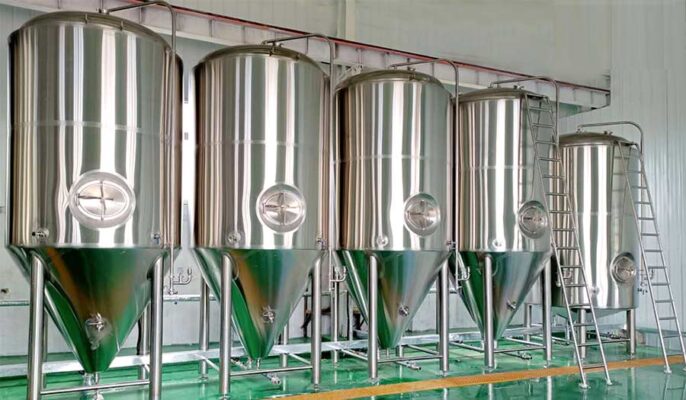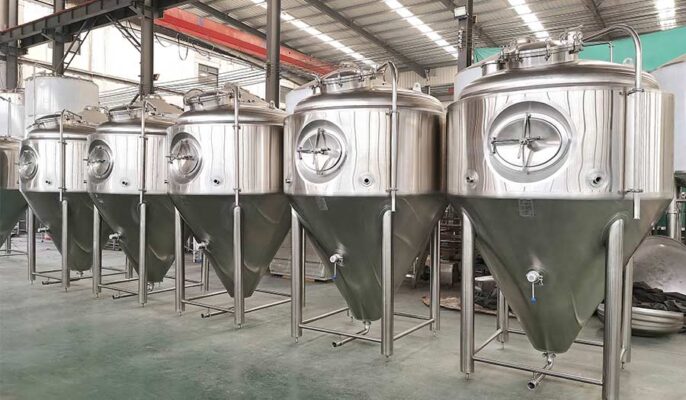발효기는 맥주 양조, 와인 양조, 기타 음료나 식품 발효에 관심이 있는 모든 사람에게 필수적인 장비입니다. 이 탱크의 주요 기능은 발효 미생물이 설탕을 알코올 및 기타 부산물로 전환하여 원하는 최종 제품을 생산할 수 있는 최적의 환경을 제공하는 것입니다.
발효기란 무엇인가요?
발효 탱크발효 용기로도 알려진 발효 탱크는 다양한 산업, 특히 맥주와 와인과 같은 주류 생산의 발효 공정을 위해 설계된 특수 용기입니다. 이 탱크의 주요 기능은 발효 미생물이 설탕을 알코올 및 기타 부산물로 전환할 수 있는 최적의 환경을 제공하는 것입니다.
발효 탱크의 특징:
- 재질: 대부분의 발효 탱크는 내식성이 뛰어나고 세척이 용이한 스테인리스 스틸로 만들어집니다. 이는 최종 제품의 순도와 품질을 보장합니다.
- 온도 조절: 발효는 온도에 민감한 과정입니다. 최신 발효기에는 온도를 조절하는 냉각 재킷이나 내부 코일이 장착되어 있습니다.
- 밀폐된 환경: 오염을 방지하기 위해 발효 탱크는 밀폐되어 있습니다. 이 밀폐된 환경은 최종 제품의 일관된 품질을 보장합니다.
- 용량: 탱크 크기: 몇 갤런의 소형 홈메이드 탱크부터 수천 갤런을 담을 수 있는 대형 상업용 탱크까지 다양합니다.

발효기의 종류
오픈탑 발효 탱크
뚜껑이나 씰이 없는 단순한 용기는 가장 기본적인 발효기 유형입니다. 뚜껑(발효 중에 표면으로 올라오는 포도 껍질과 씨 층)에 쉽게 접근하고 수동으로 누를 수 있기 때문에 와인 발효에 사용됩니다.
폐쇄형 발효조
폐쇄형 발효기에는 외부 오염물질이 발효 과정에 유입되는 것을 방지하는 밀봉된 뚜껑이 있습니다. 이는 액체가 공기에 노출되어 부패하거나 맛이 나빠지는 것을 방지하기 때문에 맥주 양조에 사용됩니다.
가변용량 발효조
가변 용량 발효기는 떠 있는 뚜껑과 조절 가능한 용량을 갖추고 있어 다양한 양의 액체를 발효하는 데 적합합니다. 유연성을 제공하고 발효액과의 공기 접촉량을 줄이는 데 도움이 되기 때문에 가정 양조업자와 소규모 양조업자에게 인기가 있습니다.
발효 탱크의 종류 구분하기:
|
탱크 유형 |
주요 용도 |
고유 기능 |
|
원뿔형 |
맥주 |
바닥이 가늘어져 효모 수집이 용이 |
|
오픈탑 |
와인 |
포도 뚜껑을 수동으로 펀치 다운할 수 있습니다. |
|
원통형 |
다용도 |
양조장에서 인기 있는 원통형과 원뿔형 디자인 조합 |
|
평평한 바닥 |
일반 |
음료뿐만 아니라 다양한 산업에서 사용 |
발효 탱크는 어떤 재료로 만들어지나요?
구리
스테인리스 스틸이 시장에 등장하기 전에는 구리가 맥주 장비 제조에 가장 많이 사용되는 금속이었습니다. 구리는 열전도율이 뛰어나 맥주 장비를 만드는 데 신뢰할 수 있는 금속입니다. 구리는 세척과 관리도 쉽습니다. 구리의 청결과 산화물 층의 무결성을 보장하기 위해 세제 또는 과탄산소다 세제를 사용하여 청소할 수 있습니다. 하지만 너무 많이 문지르면 해로울 수 있습니다.
알루미늄
알루미늄은 양조 탱크로 만들 수 있지만 맥주를 장기간 보관하는 데는 적합하지 않습니다. 알루미늄의 열전도율은 구리의 절반이지만 스테인리스 스틸보다는 낫습니다. 정상적인 양조 조건에서는 맥주에 의해 부식되지 않으며 맥주에 금속 맛을 더하지도 않습니다. 알루미늄은 구리를 포함한 다른 금속과 장기간 접촉하면 부식되지만 단기간 노출은 허용됩니다. 알루미늄 맥주 장비를 사용하는 양조업체는 내식성이 뛰어난 3003 또는 3004 등급 알루미늄을 선택합니다.
스테인리스 스틸
맥주 장비 제조에 스테인리스 스틸을 사용하는 것은 맥주 업계의 표준이 되었으며, 대부분의 양조장은 스테인리스 스틸 맥주 장비의 완전한 세트를 소유하는 것을 꿈꿉니다. 스테인리스 스틸 맥주 장비는 살균이 쉽고 맥주에 불활성이며 부식에 강하고 내구성이 뛰어납니다. 일부 양조장에서는 구리 색상이 소비자에게 더 매력적이기 때문에 맥주 장비의 외관을 구리색으로 만들기를 원합니다. 이제 스테인리스 스틸 라이너의 둘레에 구리 클래딩을 추가할 수 있습니다. 구리가 맥주와 접촉하지 않기 때문에 앞서 언급한 구리 양조 장비의 단점이 발생하지 않습니다.
다양한 종류의 발효 탱크
연속 교반 탱크 발효 탱크
연속 교반 탱크 반응기(CSTR)는 파이프, 펌프, 밸브, 교반기, 모터, 샤프트 및 임펠러가 있는 용기로 구성됩니다. 샤프트는 탱크 바닥에 위치하며 임펠러의 수는 바이오리액터의 크기에 따라 다릅니다.
공수 발효 탱크
에어리프트 바이오리액터는 중간에 배플 또는 드래프트 튜브가 있어 공기가 용기로 펌핑됩니다. 에어리프트 발효기에는 두 가지 유형이 있습니다:
내부 순환 공수 생물 반응기: 내부 순환 채널을 제공하는 중앙 배수관이 있습니다.
외부 루프 에어리프트 생물 반응기: 외부 루프가 포함되어 있어 액체를 별도의 채널로 분리합니다.
팩 베드 발효기
패킹 베드 발효기에서는 속이 빈 튜브 또는 튜브에 생촉매를 채웁니다. 베드는 고정되어 있습니다. 배양 배지는 생체 촉매를 통해 흐르고, 생체 촉매는 국물에서 대사산물을 생성합니다. 이러한 바이오리액터는 작동하기 쉽지만 산소 순환이 원활하지 않아 종종 막히기도 합니다.
멤브레인 발효 탱크
멤브레인 생물 반응기는 한외 여과 및 미세 여과와 함께 사용됩니다. 이 유형의 발효 탱크는 폐수의 생물학적 처리에 사용됩니다. 멤브레인 생물 반응조에는 두 가지 유형이 있습니다:
- 수중 멤브레인 생물 반응기: 이 유형의 발효기에서 멤브레인은 폐수에 잠긴 용기 내부에 위치합니다.
- 사이드 플로우 멤브레인 바이오리액터: 이 유형의 발효기에서는 멤브레인이 반응기 외부에 위치하며 멤브레인 여과는 공정의 추가 단계입니다.
버블 컬럼 발효 탱크
버블 컬럼 발효기는 바닥에서 가스가 주입되는 액체로 채워진 원통형 컬럼이 특징입니다. 바닥에서 가스가 유입되면 난류가 발생하여 최적의 가스 교환이 이루어지도록 배열되어 있습니다. 스프레더는 용기의 내용물을 혼합합니다. 액체는 평행 또는 역류 방향으로 흐릅니다.

적합한 발효 탱크를 선택하는 방법은 무엇인가요?
발효 유형
발효의 종류에 따라 장비의 종류도 달라져야 합니다. 예를 들어 알코올 발효의 경우 재료를 쉽게 첨가할 수 있도록 입구가 넓은 발효 용기가 필요합니다. 혼합 발효의 경우 뚜껑이 꼭 맞는 발효 용기와 온도를 확인할 수 있는 온도계가 필요합니다.
장비 크기
발효 장비를 구매할 때는 장비의 크기와 발효할 액체의 양을 고려하는 것이 중요합니다. 홈 브루잉이나 소량 식품 발효와 같이 소량의 액체를 발효할 계획이라면 더 작은 발효 용기가 적합합니다. 일반적으로 유리나 플라스틱으로 만들어지며 1갤런 용기에서 5갤런 또는 6갤런 용기에 이르기까지 다양한 크기로 제공됩니다. 상업용 양조나 대량 식품 발효에 사용되는 것과 같이 많은 양의 액체를 발효할 계획이라면 더 큰 발효 용기가 더 적합할 것입니다.
온도 제어
일부 발효 용기에는 단열 또는 냉각 시스템과 같은 온도 조절 기능이 내장되어 있습니다. 이는 특정 온도 범위 내에서 발효하는 경우 특히 중요합니다. 발효를 위한 특정 온도 요구 사항이 없는 경우에는 중요하지 않을 수 있습니다.
에어록 유형
발효 장비를 구매할 때는 발효 공정에 적합한 에어락 유형을 고려하는 것이 중요합니다. 가장 일반적인 에어락 유형 중 하나는 간단하고 저렴한 옵션인 S-튜브 에어락입니다. 또 다른 유형의 에어락은 일반적으로 플러그, 밸브, 튜브가 포함된 3피스 디자인입니다. 이 유형의 에어록은 더 복잡하지만 더 많이 밀봉하고 청소 및 유지 관리가 더 쉽습니다.
예산
장비의 비용을 고려하고 예산과 원하는 기능의 균형을 맞추는 것이 중요합니다. 발효 장비의 가격은 S-튜브 에어락과 같은 간단한 장비의 경우 몇 달러부터 산업용 스테인리스 스틸 발효 탱크와 같은 더 크고 복잡한 장비의 경우 수천 달러까지 다양합니다. 원하는 발효 유형에 필요한 기능을 제공하면서 예산에 맞는 장비를 선택하는 것이 중요합니다.
생산 능력
발효 장비를 선택할 때는 장비의 생산 능력을 고려하는 것이 중요합니다. 즉, 장비가 주어진 시간에 생산할 수 있는 최대 제품량을 고려해야 합니다. 장비가 공장의 생산 요구 사항을 충족할 수 있는지 확인하는 것이 중요합니다.




